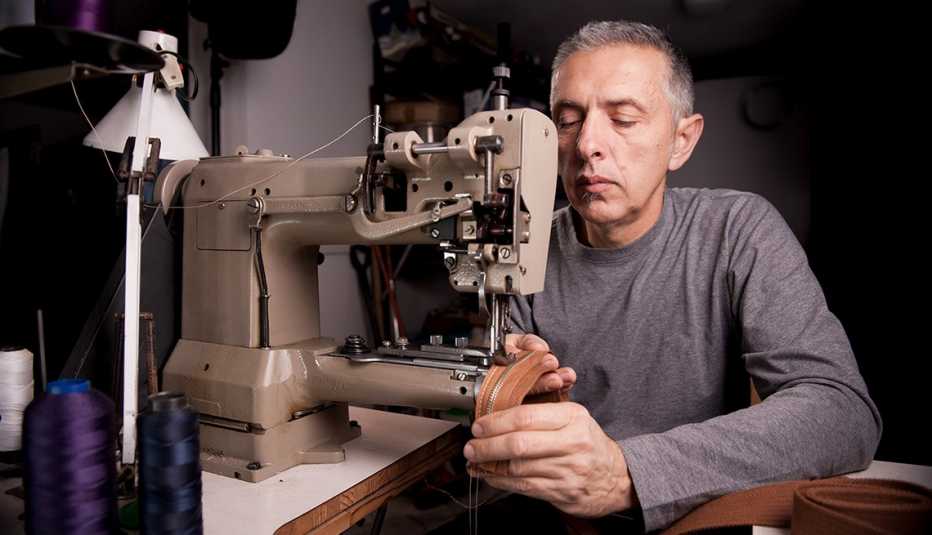Staying Fit


|Some things can't be taught; they just come naturally. We're all born with a distinctive set of talents that are as singular as fingerprints. These are not skills we learn along the way or passions we discover over the years. These are inborn gifts. It's the way your voice sounds, for instance, your athletic prowess or your inner mechanical capability.
If you aren't certain what you have a knack for, ask friends, relatives and colleagues. They may point out things you simply take for granted. Think about the stuff you've been good at since you were a kid. If you're unsure, though, several organizations, including the Rockport Institute, provide career-testing programs that can help you assess your natural talents. And AARP's LifeReimagined.org offers interactive programs that help you identify your interests, values, goals and purpose.


AARP Membership— $12 for your first year when you sign up for Automatic Renewal
Get instant access to members-only products and hundreds of discounts, a free second membership, and a subscription to AARP the Magazine.
Here are five jobs where you can follow your talent to make money. These jobs may offer flexible hours and may be done on a full- or part-time basis. Pay varies depending on the employer, your experience and your location.
1. Voice-over actor/artist
Do you have a money voice? If you've been blessed with a deep, resonating timbre or, perhaps, a smoky, husky purr, it might be time to put your vocal cords to work. The need for voice talent is rising. That's thanks to the increase in online multimedia websites and audiobooks.
The variety of possible gigs ranges from commercials to Web videos, audiobooks, documentaries, business and training videos, telephone messages and applications. This is generally a job for freelancers, and your services may be required for only a single recording session.
Qualifications: You'll probably have to invest in equipment such as recording software, a microphone and headsets if you are working from your home studio. You'll also need to shell out for a professional demo, to send to prospective clients. An acting background helps, although it's not mandatory. A few websites to check out for more information are Voices.com, Voicebunny.com and Voice123.com, which can help voice actors find work. To get higher-paying voice-over gigs, you may need to join a union such as SAG-AFTRA, the combination of the Screen Actors Guild and the American Federation of Television and Radio Artists. Union fees will vary depending on your market.
2. Medical equipment maintenance and repair
Were you the kid who always took things apart in the garage for the sheer fun of putting them back together? From wheelchairs to gurneys, if you've got the fix-it gene, this is a fast-growing job that plays right into your innate mechanical ability.
Medical equipment repairers maintain and fix a variety of equipment, including electric wheelchairs and EKG machines. For the most part, the tasks call for steadiness and good hand-eye coordination. But it's the inner awareness of how things work and fit together that allows you to not only enjoy this job but also to succeed in it. It can be physically demanding, as bending, crouching and standing go with the territory.
Employment of medical equipment repairers is projected to grow 30 percent from 2012 to 2022 — much faster than the average for all other occupations, according to the Bureau of Labor Statistics. Greater demand for health care services and the use of increasingly complex medical equipment will drive employment growth. Those who have an associate's degree in biomedical equipment technology or engineering should have the best job opportunities.
As you might expect, openings can be found at hospitals, assisted care communities, medical centers, physicians' offices, health and personal-care stores, and medical equipment wholesalers. You might be called in for emergency repairs, so the ability to work quickly under pressure must be one of your talents.
Pay: a median of $44,570 per year; $21.43 per hour, according to the Bureau of Labor Statistics.
Qualifications: Education requirements for medical equipment repairers are based on the kinds of equipment used in the position. So, for example, if you stick to hospital beds, gurneys and electric wheelchairs, you may learn entirely through on-the-job training. Medical device manufacturers, too, often provide technical training. If you work on high-tech equipment, such as CAT scanners and defibrillators, however, you may need a bachelor's degree in engineering or biomedical equipment technology. Even so, medical equipment technology is swiftly advancing, and new devices are being introduced all the time.
As a result, repairers must constantly update their skills and knowledge of equipment. Employers, particularly hospitals, often pay for their in-house medical repairers to become certified. The Association for the Advancement of Medical Instrumentation (AAMI), for one, offers certification in specialty areas including certified biomedical equipment technician, certified radiology equipment specialist and certified laboratory equipment specialist.



































































More on work
20 Jobs That Employers Are Filling Now
Some of these occupations offer work-from-home opportunities and flexible hours
How to make sure the position is a good fit before you say yes
Before you accept that new opportunity, here are nine questions you should ask to make sure it meets your needs
Tell The Right Story About Yourself
Harness one of the most powerful forces to shape your future